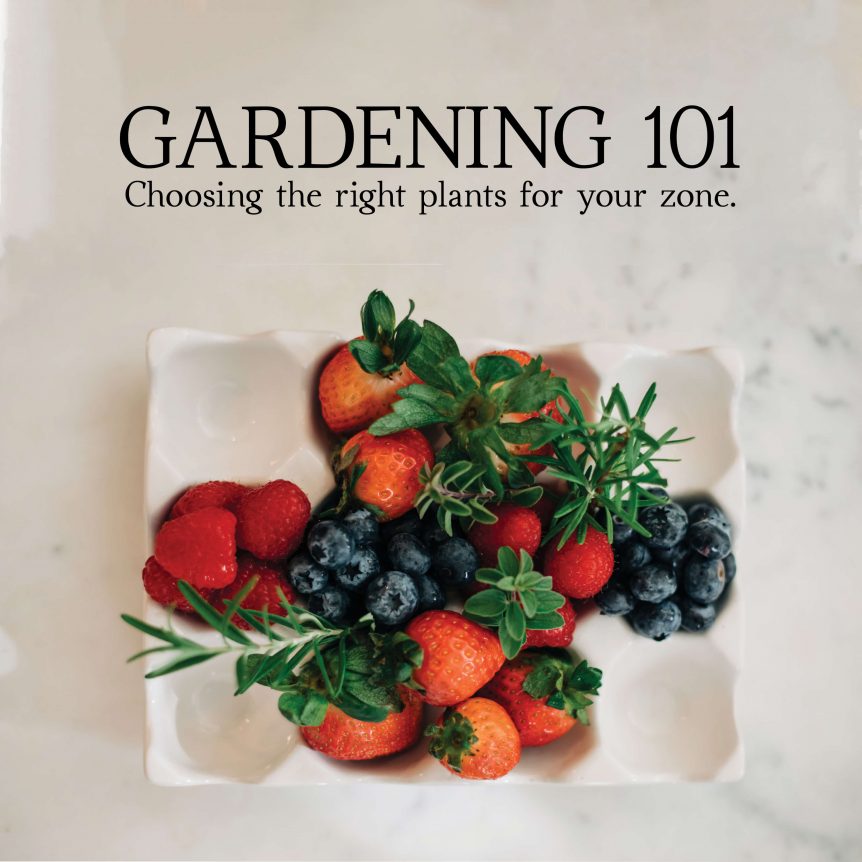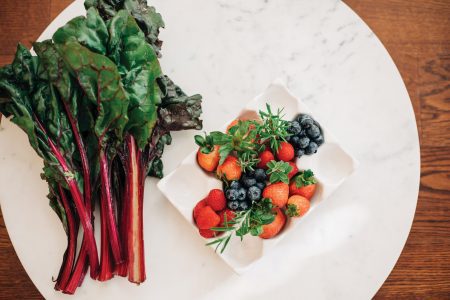Written by Isabella Caprario, Porch.com
Photography by Brittany Strickland
Starting a garden is an excellent way to enjoy beautiful plants and delicious fruits, herbs, and vegetables right in your backyard. As a new gardener, it’s vital to be sure you’re choosing plants that will thrive in your climate. The USDA Plant Hardiness Zone Map helps you determine which plants will grow best in your part of the country. Knowing what to plant in your garden means a successful yield, year after year. Read on for some helpful gardening tips that will ensure your fruit, herbs, plants, and flowers live long and prosper.
What are the USDA Plant Hardiness Zones?
The USDA (United States Department of Agriculture) designed a map of the United States that separates different country regions into 11 numbered zones. Each zone is approximately 10 degrees Fahrenheit warmer or colder in an average winter than the zone directly adjacent to it. Most plants you purchase from your local nursery or home improvement store will list their hardiness zones on the packaging to help make your selection easier. These zones are crucial to determine which types of plants will survive the winter in various regions of the country. If temperatures get too cold, certain species will perish, while others may thrive, depending on their hardiness zone.
These plant hardiness zones are established to help make gardening and growing plants more manageable. They’re also vital for farmers or anyone who needs to plant fruits and vegetables for survival. Hardiness zones are most important when planting perennial plants since they typically live past a single growing season. If you’re planting perennials in your garden, you’ll need to know which ones will survive the winter based on their zone.
Any plant in your garden that’s outside of its hardiness zone will likely wilt, have stunted growth, or die completely. That’s why it’s essential to grow plants that are suitable for your specific region and climate. Understanding how plants and climate are related will make it much easier for you to plant and enjoy a successful garden for the long-term.
Once you have a vision for your garden, it’s a good idea to establish a planting calendar. This calendar can help you plant a variety of different items at specific times of the year to ensure good growth. Knowing when to plant veggies, flowers, herbs, and fruit is a wise way to keep your garden happy, healthy, and beautiful.
What is a planting calendar?
A planting calendar helps you to calculate the best time of year to start seeds and plant your garden. This calendar times your planting based on the first and last frost dates in your region. Frost dates are the first and last average day (or range of days) when frost is common in a specific zone. Since many plants cannot handle the extreme cold temperatures of frost, make a note of your frost date so that your plants are protected.
How to calculate plant dates?
To help you calculate your plant dates, use the first or last frost dates for your zone or zip code as a guide. Ideally, you should plant items in the spring after your last expected frost date, and items in the fall before your first expected frost date. If you plant something too early in the spring, nighttime temperatures may dip too low for it to survive. Items planted too late in the fall may be vulnerable to the frost of winter before they’re fully established.
 How to use your planting zone
How to use your planting zone
Before you begin planting your garden, determine your hardiness zone. You can find this by visiting the USDA website and entering your zip code, or by viewing the USDA Plant Hardiness Zone Map and finding your location. Once you know your zone, look for plants that have it listed on the tag. Most nurseries will also include the range of temperatures at which different plants are “hardy,” or able to survive.
It’s important to note that climate isn’t the only factor that affects the hardiness of plants. The amount of sunlight, water, and nutrients in the soil also play a vital role in their survival. While you should always select plants that are within your zone only, they should also be planted in the right areas of your yard to ensure they get the amount of sunlight they need.
Louisiana. With its mild climate and plenty of moisture, Louisiana is located in USDA hardiness zones 8-10.
Planting vegetables, flowers, herbs, and fruit
When to plant vegetables?
It’s best to plant your vegetables when there is no longer a risk of frost. This is particularly important when plants are new and quite vulnerable to the dangers of frost and extreme cold. Certain types of vegetables do well in the warmer summer months, such as corn or tomatoes. Others can survive just fine when planted in early spring, like kale or broccoli. In general, plant your vegetables when the danger of frost is completely gone to ensure success.
When to plant flowers?
Use your first and last frost dates as a guide when planting flowers. Check the type of flower carefully to determine if it’s able to remain hardy in your planting zone. Some species of flowers can survive a light frost, while others require the soil to remain at consistently warm temperatures to thrive. Take the type of flower and your frost dates into account before you begin to plant flowers to ensure colorful, bountiful blooms.
When to plant herbs?
You can start most types of herbs from seed and keep them indoors or outside in a protected area. Most young starter herbs (small, young plants) can be put directly in the ground, but new seeds should be germinated indoors. Check the specific planting instructions for each herb to determine which ones can be started outside. All herbs should be planted at least several weeks before the last frost for best results.
When to plant fruit?
Fruit trees should be planted in the early spring or late winter if you’re planting them in the ground. However, if you plan to grow fruit trees in containers, they tend to do best between September and May. Avoid planting fruit trees in the peak of winter, since frost is almost always guaranteed to damage or kill most plants that bear fruit. Certain fruits that go in the ground, like strawberries, should be planted approximately six weeks before the last frost date in your zone.
Indoor and outdoor seeds
If you’re planning to start your garden from seeds, certain plants do best when germinated indoors, while others may thrive outside. Growing seeds indoors protect the new plants from the dangers of pests, inclement weather, and hungry wildlife. However, many plants prefer to begin their lives with the seeds placed directly in the soil. If you’re starting your garden with seeds rather than starter plants, check the packaging carefully for growing instructions. Most will show you whether the plant should be germinated inside first, or if it will do better by being sown outdoors.
- Rooted vegetables like carrots and radishes prefer to grow from seed directly planted in the ground.
- Tomatoes, peppers, and eggplant yield much better crops when started indoors, then transplanted outside once they’re established.
- Vegetables that enjoy heat like cucumbers, melons, and beans do best when sown in the ground after the risk of frost has passed.
- Many annual flowers like petunia or amaranth prefer to be started indoors. Others like cosmos, zinnia, and marigold prefer to be planted from direct-sown seed.
- Flowers like morning glory and poppies do best in cool soil and prefer to be planted directly into the ground early in the season.
Gardening Tips:
Now that you know more about plant hardiness zones, it’s time to get your garden started. Here are some helpful gardening tips that will make the process easier.
Pick a spot. Choose an area of your backyard where your garden will get the best sunlight, and that’s easiest for you to access. Most plants require 6-8 hours of sunlight each day to thrive.
Clear the ground. Remove grass, weeds, and rocks from the area, and clear a space where your garden can grow. Add a layer of compost in winter so that it’s ready for planting by spring.
Improve the soil. Fertilize your soil using organic matter, such as decaying leaves, grass clippings, or compost to give it a boost of nutrients.
Work the soil. You’ll need to till the soil to create a healthy environment for roots. Use a rototiller to gently till the soil without overworking it so that it doesn’t disturb microorganisms that may live there.
Pick your plants. Choose your new plants for the garden based on their hardiness zone and your planting calendar. Look for healthy starter plants at your local nursery or shop online. You can start slowly with a few easy plants before moving on to more.
Plant. Dig holes in your garden area, and place your plants in a row, making sure that you space them apart according to the planting instructions. Gently loosen the roots before placing them into the ground, then cover each plant with a layer of soil and water them.
Water. Water your seedlings daily, and water your transplants every other day or so. Once the plants in your garden are established, you can water them based on your climate, soil moisture levels, and how much water each type of plant requires for maintenance. Water your garden as early as possible each day to minimize evaporation.
Maintain your garden. Keep your garden healthy by pruning off dead leaves and branches. Remove weeds as needed, and look for signs of pests so you can keep them under control. Cover your soil with approximately two inches of mulch to keep moisture in and weeds out.
With the right plants for your climate and hardiness zone, you can enjoy a successful, beautiful garden that will last for years to come. Start by learning about your specific climate, and only choose plants that you know will thrive. Use a planting calendar to help you determine the times of the year when frost is present. With some practice, time, and patience, you can enjoy a fruitful garden that thrives


 How to use your planting zone
How to use your planting zone